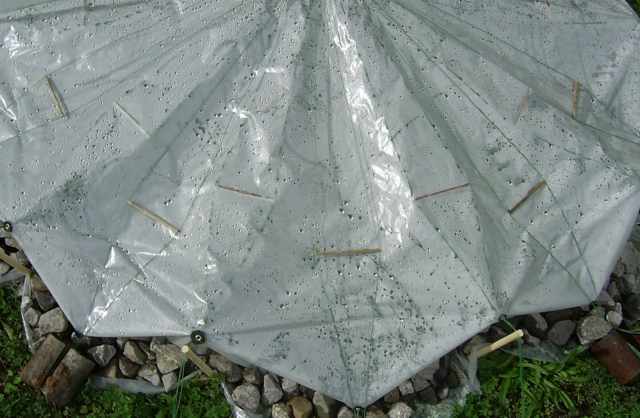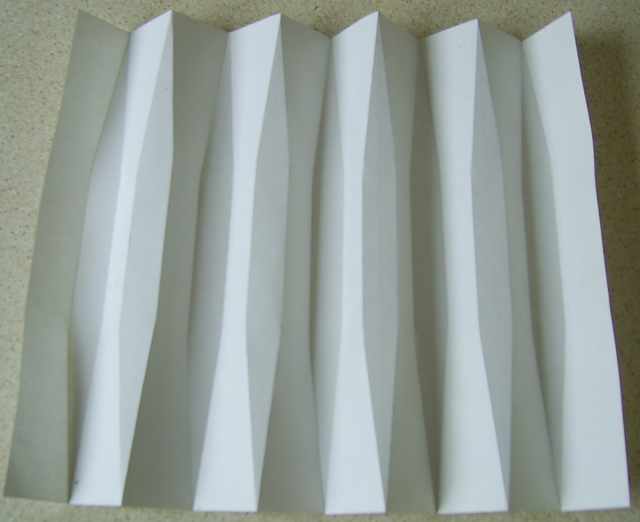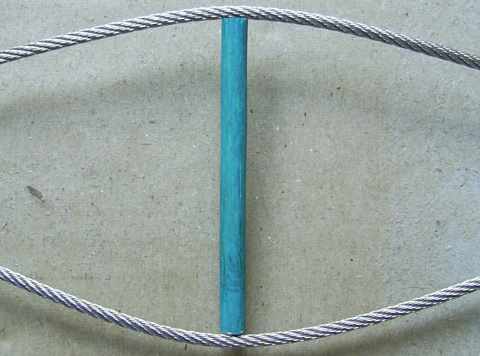Blunt pleats

Blunt pleats
The problem
This page deals with the issue of how to eliminate areas of
high tension in pleated structures made using flat sheets of
material.
Use of flat, unpatterned material usually requires that the
ridge and valley cables be tensioned so they are completely
straight - in order to avoid the membrane forming
doubly-curved surfaces.
In structures where there is a membrane prestress,
this means that the tension in the cables
needs to be very large by comparison.
While pleated structures require minimal membrane prestress,
some prestress is still needed - just to take out
wrinkles in the fabric.
Consequently, in order to tension the cables
with enough force to make them straight considerable
force needs to be applied.
The side-effects of this include the need for thicker
cables, thicker struts and larger ground anchors - all of
which contribute to greater cost.
If insufficient forces is applied to the cables then they
will form catenary curves - under the prestress force
applied by the membrane.
The formation of catenary curves means that a flat membrane
will not fit smoothly in over the resulting structure
without stretching.
The fabric is likely to be stretched at either end of each
pleat.
This will create stress in the fabric where it contacts the
ridge and valley cables - resulting in an increased
probability of it tearing or failing at those points.
High membrane tension at each end of the peats is likely to
be accompanied by low membrane tension in the middle of
them. Such areas of low membrane tension may result in
the membrane flapping against the cables. This is likely to
results in cumulative membrane damage.
Patterning
Of course, the conventional solution to this problem
involves patterning the fabric.
Patterning results in a much more even distribution of
tension along the pleat.
However there are some disadvantages to patterning:
- It is time-consuming and expensive to do;
- It often requires specialised equipment;
- It creates weaknesses in the fabric;
- It creates potential leaks;
- It wastes fabric;
- It makes the fabric harder to reuse.
Between them, these disadvantages are enough to
motivate a search for methods of construction which
do not require patterning.
Blunt pleats
In a case of pleated structures, doubling up the ridge and
valley cables and inserting spacers can result in pleats
with what appear to be blunt edges.
Taking the 'edges' off the middle of the pleats results in
ridge cables that form natural catenary curves - while still
retaining the ability to use a flat membrane to cover them.
The digrams here illustrate the pattern:

Blunt pleats - tensile structure model
Here a tensile structure employs twin ridge and valley
cables with single strut spacers.
There approximate the desirable curved oval shape of blunt
pleats.
More information about this model is available
here.

Blunt pleats

Blunt pleats - cables separated by strut spacer
Approximation

Curved pattern
|
|

Linear approximation
|
A curved pattern would distribute forces best along the
length of the cable.
In practice, this is approximated - using a series of
straight line segments.
Disadvantages
Use of this pattern allows membrane patterning to be dispensed with -
but there are a number of disadvantages to using it:
- the number of ridge and valley cables is doubled;
- more struts are used - increasing the weight;
- more strut material is placed in contact with the membrane;
- more strut-to-cable joins are produced, increasing complexity;
- adjusting cable tension involves more maintenance problems;
- cables can no longer be tightened as far as they will go;
- external strut material interferes with drainage.
The problems are a bit different for ridge and valley cables.
The idea makes more sense for ridge cables - because fewer
disadvantages apply in that case.
In particular:
- adjusting the struts is less likely to involve climbing on the structure;
- the struts are less exposed to the elements;
- the struts are less likely to interfere with drainage or create puddles.
Links
The essay on softer boundaries is related to this one.
|